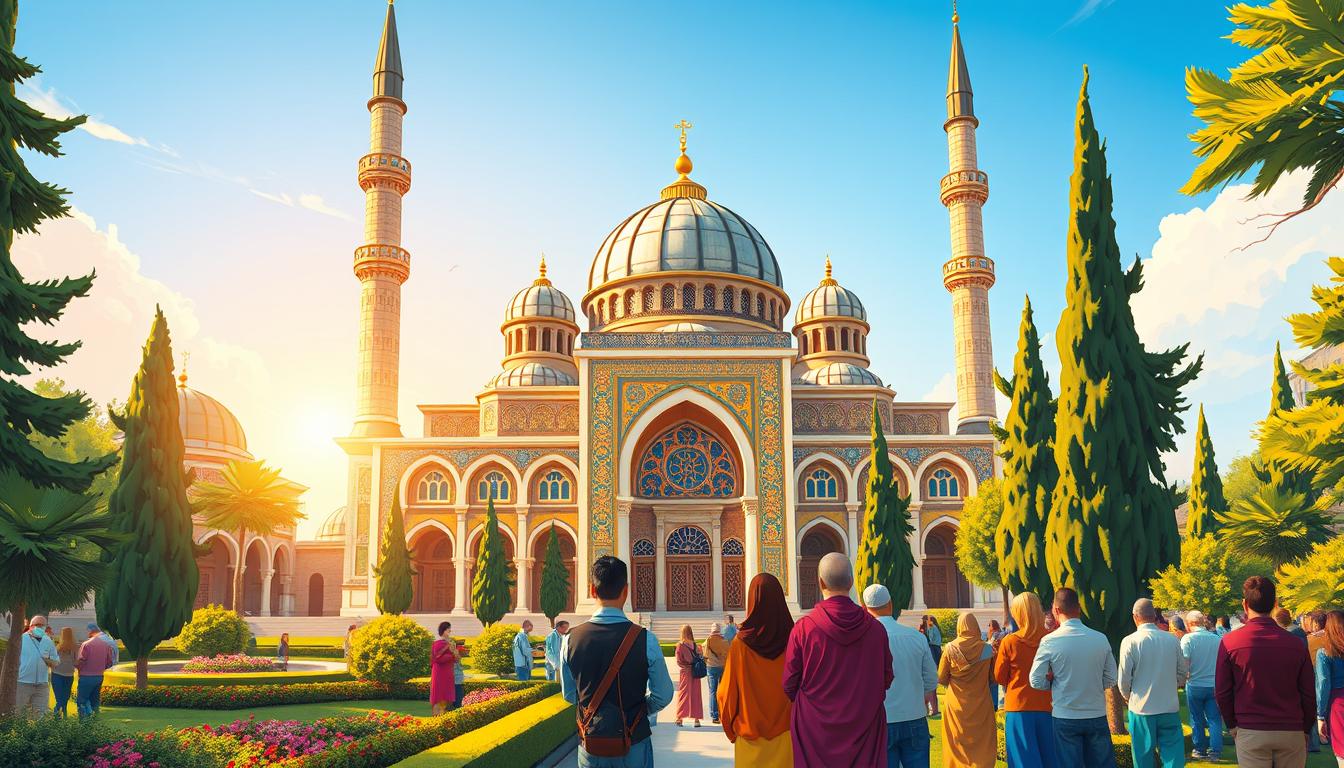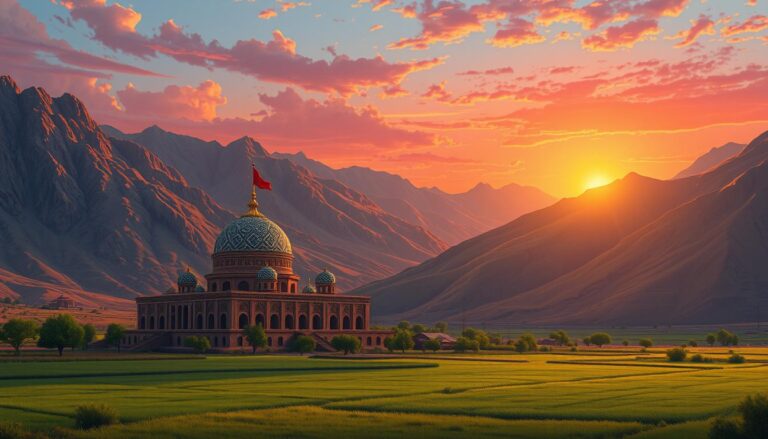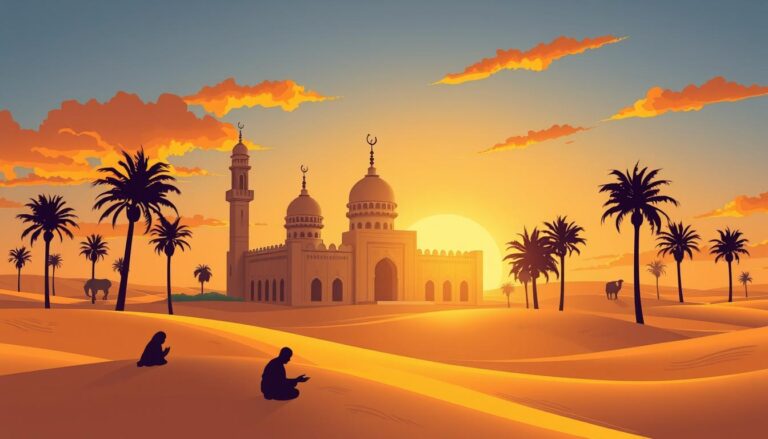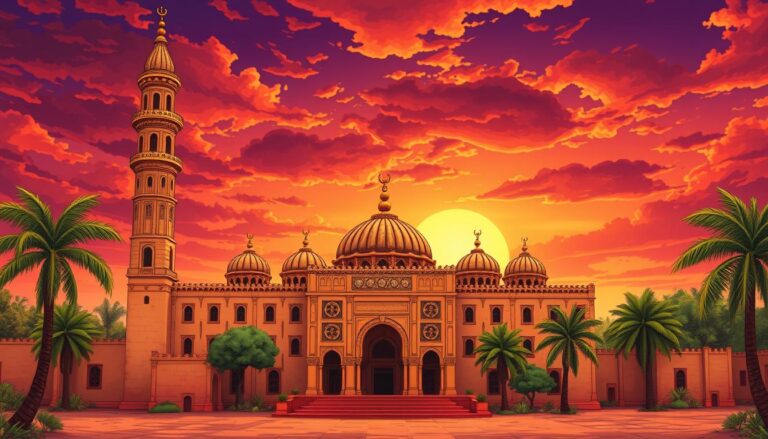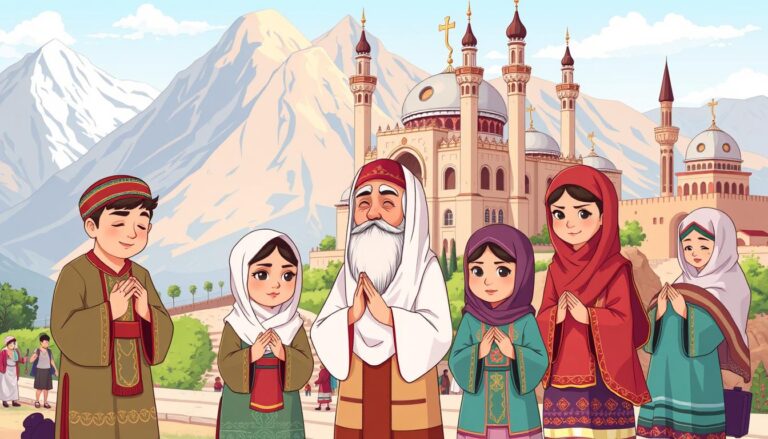Islam in Iran
Islam started coming to Iran in the 7th century, after the Prophet Muhammad founded it. The Arab conquest of Iran led to the fall of the Sasanian Empire. This change brought Islam to the forefront, replacing Zoroastrianism as the main religion.
Over time, most Persians turned to Islam. Sunni Islam was the main branch until the 16th century. Then, the Safavid dynasty worked to make Shia Islam the official religion of Iran.
This move caused tension with the Sunni-majority Ottoman Empire next door. Today, about 80% of Iranians are Shia Muslims. The other 20% are mostly Sunni. The Islamic Republic of Iran bases its politics and society on Shia Islam. Ayatollahs and the Shiite clergy are key in Iran’s government.
Introduction to Islam in Iran
The Arab conquest of Iran in the 7th century AD was a big change. Zoroastrianism, the main religion, was replaced by Islam. This change took many years and deeply influenced Iranian culture and identity.
Historical Overview of Islam’s Arrival in Iran
Islam started spreading in Iran soon after it was founded. The Arab conquest led to the fall of the Sasanian Empire. This changed Iranian society a lot.
Many Persians became Muslims over time. Sunni Islam was the main branch until the 16th century.
The first to convert were the nobility and city people. But, the peasants and landowners took longer. By the 10th century, Iran was fully Arabized.
Significance of Islam in Iranian Culture
Islam’s arrival deeply changed Iran’s culture and identity. The Abbasid revolution helped Islam become even more important. This event was key in spreading Islam across the region.
“The process of Islamization in Iran took place over many centuries, with the nobility and city-dwellers being among the first to convert, while the peasantry and the land-owning magnates took longer to do so.”
Today, Iran is the only country ruled by clerics. The Shiite branch of Islam is the main one. This has greatly shaped Iran’s politics, society, and culture. Islam is a big part of who the Iranians are.
Shia Islam: The Dominant Sect in Iran
Iran is mostly Shia Muslim, with about 80% of people following Twelver Shia Islam. This branch is the official religion and has a long history in Iran. The other 20% are mostly Sunni Muslims, from ethnic groups like Arabs and Kurds.
The core of Iranian Shiʿism is the belief in the 12th imam’s return. People also honor his martyred ancestors. This Shia identity has shaped Iran’s culture and politics for centuries. The Safavid dynasty made Shia Islam the state religion in the 16th century.
Shia Islam’s dominance in Iran has caused tensions with Sunni minorities and Sunni-majority countries like Saudi Arabia. The Iranian government’s treatment of religious minorities is a worry for human rights groups and the world.
Despite these issues, Shia Islam is at the heart of Iran’s identity. It’s deeply connected to the nation’s history and people’s hopes. Knowing about Shia Islam in Iran helps us understand the country’s complex social, political, and religious scene.
The Safavid Dynasty and the Spread of Shia Islam
In the 16th century, the Safavid dynasty started a big push to make Shia Islam Iran’s main faith. They wanted to replace Sunni Islam and forced many Iranians to convert. This move made the Sunni-majority Ottoman Empire very upset, especially because many non-Shia people had to leave Iran.
Forcible Conversion and Tensions with the Ottoman Empire
The Safavids were very hard on Sunni Muslims, Jews, Christians, and others. They wanted to wipe out Sunni Islam. Ismail I, the first Safavid Shah, made Shiism the only religion allowed, destroying Sunni mosques and killing many Sunnis.
Many Sunni scholars who didn’t want to switch to Shia Islam were killed or had to leave. This was a very difficult time for them.
The Synthesis of Iranian Culture and Shia Islam
Over time, Shia Islam and Iranian culture became deeply connected. This created a special religious identity for Iran. By 1501, Ismail I had become Shah and had taken over most of Iran in 10 years.
Under Shah Abbas I, trade with the West grew, and Iran became a major power. This was a great time for Iran’s economy and culture.
“The Safavid rulers took steps against Sunni Ulama, giving them the choice of conversion, death, or exile, and massacred Sunni clerics who resisted the Shia transformation of Iran.”
Religious Minorities in Iran
Iran is mostly Muslim, with over 99% of people identifying as such. But, it also has many religious minorities. Christians, Jews, and Zoroastrians are among the most well-known. They are recognized in the Iranian constitution as official minorities.
Christians, Jews, and Zoroastrians
In Iran, Christians are mostly Orthodox Armenians. Assyrians also live there, belonging to different Christian denominations. Zoroastrians, an ancient Persian faith, live mainly in Yazd, Kerman, and Tehran.
Even though these groups are officially recognized, Iran’s post-1979 Islamic Revolution has been tough for them. It has made it hard for them to be treated equally.
Persecution of the Baha’i Faith
The Baha’i faith, founded in Iran, has faced the worst persecution. Baha’is have been discriminated against and repressed. The government doesn’t recognize the Baha’i faith as an official religion.
Reports say over 1,000 Baha’is have been jailed. Authorities have shut down many Baha’i businesses. Several people have been sentenced to long prison terms for their faith.
The way Iran treats religious minorities, especially Baha’is, worries the world. The United Nations has passed resolutions about the growing restrictions and violence. This is a big human rights issue in Iran.
Islam in Iran
Iran is a country where Islam deeply influences its identity and policies. The 2016 census showed 99% of Iranians are Muslim, with 80% Shia and 20% Sunni. But, recent surveys indicate a drop in religiosity, with only 40% identifying as Muslim in 2020.
The Iranian constitution calls Iran an Islamic republic. It states Twelver Ja’afari Shia Islam as the official religion. This means laws must follow Islamic principles, favoring Shia Islam and limiting rights of minorities.
The government’s policies affect religious demographics, government policies, and religious freedom. These include persecution of minorities, discrimination, and strict Islamic dress codes and morality laws.
“The Islamic Republic of Iran celebrated its fortieth anniversary in February 2019, but the country has faced recurring protests against the regime’s influence and repression.”
The relationship between Islam in Iran and government policies is complex. There are ongoing debates about religion’s role in the nation.
In recent years, Iran has enforced strict Islamic laws, causing tensions and protests. The religious freedom of Iranians is a major concern. The government has targeted and persecuted religious minorities, including Baha’is, Christians, and Sunni Muslims.
Despite efforts to keep an Islamic identity, Iran’s religious landscape is changing. Surveys show a decline in Muslims, with many embracing secular or spiritual beliefs. This shift shows Iran’s religious sentiments are evolving.
The Role of the Ulama and Clerical Hierarchy
In Shiite Islam, the ulama lead spiritually and legally, not a priesthood. To join the Shiʿi ulama, a male Muslim must go to a traditional Islamic college or madrasah. He must show great scholarly skill, recognized by the clergy.
The mujtahid is the most respected title among the ulama. He can make legal judgments on his own. The title of ayatollah is given to mujtahids with outstanding knowledge in Islamic law. The highest honor is the title of grand ayatollah, or marjaʿ-e taqlīd, for those who are the best examples for followers.
The influence of the ulama in Iran has changed over time. In the Safavid Empire (1501-1736), they supported the Shahs’ rule. But under the Qajar dynasty (1794-1925), they faced challenges from modernization and secularization. This led to a period of conflict between the clergy and the government.
“The structural transformation of religious authority from the imams to the scholars was completed by the 19th century.”
Islamic Laws and Practices in Iran
Iran’s constitution says all laws must follow “Islamic criteria” and sharia, Islam’s religious law. This has deeply influenced Iran’s laws and legal system.
Hudud Punishments and the Penal Code
The Iranian penal code includes harsh hudud punishments like amputation, flogging, and stoning. These are for crimes like adultery, drinking alcohol, and theft. The code also calls for the death penalty for proselytizing and trying to convert Muslims, as well as for insulting the Prophet or Islam.
Restrictions on Religious Conversion
Iran’s laws make apostasy, or leaving Islam, a crime. It’s illegal for Muslims to change or deny their faith. This makes it hard and risky for people to switch religions.
“The adaptation to Islam by Iran commenced in history, with notable battles such as the Muslim defeat of Sassanian forces at Qadisiyyah in 636 and the 642 battle of Nahavand marking significant events in the process.”
Sharia law and Islamic principles deeply affect Iran’s citizens, especially in criminal punishments and religious freedom. These practices are a big issue, causing controversy and human rights concerns worldwide.
The Islamic Revolution of 1979
In 1979, a big change happened in Iran. The Islamic Revolution ended the Pahlavi dynasty and started the Islamic Republic. Ayatollah Ruhollah Khomeini led this change, wanting Iran to be an Islamic state.
The End of the Pahlavi Dynasty
The Pahlavi dynasty ruled Iran for over 50 years. But protests and unrest grew, sparked by disrespect towards Khomeini. The Shah tried to stop the protests with martial law and violence.
The oil strikes also hurt the Shah’s power. People stopped working in the oil fields, showing their support for the protests.
The Establishment of the Islamic Republic
After the Shah left in January 1979, Khomeini returned on February 1st. The military stayed out of it, helping the monarchy fall. This led to the Islamic Republic’s birth.
The new government quickly changed the old Persian Constitution. They made a new one based on Islamic rules, including Velâyat-e Faqih.
This revolution changed Iran’s politics and religion. Shia Islam became the main force in government and society. Iran became active in supporting Shia groups in the Arab world.
“The revolution was a popular uprising against the Pahlavi dynasty and a complete break with the past. It aimed to create a new political, social, and economic order based on Islamic principles.”
Contemporary Issues and Challenges
Iran’s Islamic government has faced criticism for its treatment of religious minorities. It enforces strict Islamic laws. The persecution of religious minorities, including Baha’is, Christians, and Sunni Muslims, is a big concern.
Authorities have arrested, detained, and executed people accused of “enmity against God” and “insulting Islamic sanctities.” Religious minorities face discrimination in education and jobs. They also lose their properties.
Enforcing Islamic Dress Code and Morality Laws
The Iranian government strictly enforces an Islamic dress code and morality laws. This has led to protests, like after Mahsa Amini’s death in 2022. These actions have been criticized by human rights organizations worldwide.
“The Iranian regime has been linked to killing hundreds of protesters, with estimates reaching possibly over 1,000 individuals since mid-November.”
Despite the crackdown, the Iranian people want freedom and democracy. They show a strong pro-Western sentiment. But, their rights advocacy is met with violent suppression by the authorities.
The Islamic Republic of Iran ignores human rights and supports terrorist proxies. This makes it a complex issue globally. The government’s focus on its ideology over citizens’ needs continues the fight for religious freedom and civil liberties in Iran.
Conclusion
The story of Islam in Iran is complex and rich. Shia Islam has been the main sect since the 16th century. It has shaped Iran’s politics, society, and daily life.
This mix of Iranian culture and Shia beliefs has created a unique identity. This identity is still growing and changing.
Most Iranians are Shia Muslims, but there are many religious minorities. These include Christians, Jews, Zoroastrians, and Baha’is. The government’s focus on Shia Islam has caused tension and human rights issues.
Iran’s future will depend on balancing religious diversity with Shia Islam’s dominance. Iranian society is deeply religious but also modern. This shows that tradition and modernity can blend together.
Source Links
- Islam in Iran
- Iran – Religion, Islam, Shia
- Islamization of Iran
- Iran and Islam
- Iran and Islam
- The Sunni-Shia Divide
- Islam’s Sunni‑Shia Divide, Explained | HISTORY
- Safavid conversion of Iran to Shia Islam
- Safavid dynasty | History, Culture, Religion, & Facts
- Religion in Iran
- Iran – United States Department of State
- Iran – United States Department of State
- Iranians Turn Away from the Islamic Republic | Journal of Democracy
- The Islamic Republic Is Killing Islam in Iran
- How the Shi‘ite Clergy Entered Politics
- Judicial system of the Islamic Republic of Iran
- No title found
- Constitution of the Islamic Republic of Iran | Refworld
- Reconstructed Lives: Women and Iran’s Islamic Revolution
- Iranian Revolution | Summary, Causes, Effects, & Facts
- Iranian Revolution
- The Islamic Republic of Iran: A Dangerous Regime – United States Department of State
- The Challenge of Iran
- The Strategic Culture of the Islamic Republic
- Iranians under the Islamic regime: more or less religious?

